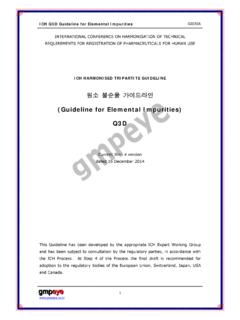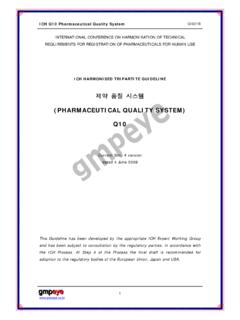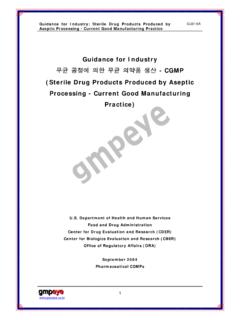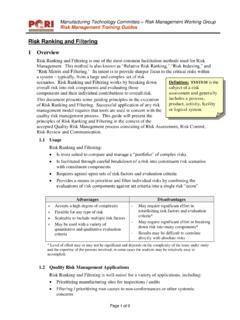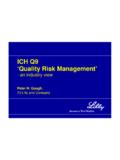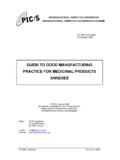Transcription of 품질 리스크 관리 - gmpeye.co.kr
1 ICH Q9 Quality Risk Management GI002C gggmmmpppeeeyyyeee 1 INTERNATIONAL CONFERENCE ON HARMONISATION OF TECHNICAL REQUIREMENTS FOR REGISTRATION OF PHARMACEUTICALS FOR HUMAN USE ICH HARMONISED TRIPARTITE GUIDELINE (QUALITY RISK MANAGEMENT) Q9 Current Step 4 version dated 9 November 2005 This Guideline has been developed by the appropriate ICH Expert Working Group and has been subject to consultation by the regulatory parties, in accordance with the ICH Process. At Step 4 of the Process the final draft is recommended for adoption to the regulatory bodies of the European Union, Japan and USA. ICH Q9 Quality Risk Management GI002C gggmmmpppeeeyyyeee 2 Q9 Document History First Codification History Date New Codification November 2005 Q9 Approval by the Steering Committee under Step 2 and release for public consultation 22 March 2005 Q9 Q9 Approval by the Steering Committee of Post Step 2 correction 15 June 2005 Q9 Current Step 4 version Q9 Approval by the Steering Committee under Step 4 and recommendation for adoption to the three ICH regulatory bodies.
2 9 November 2005 Q9 ICH Q9 Quality Risk Management GI002C gggmmmpppeeeyyyeee 3 QUALITY RISK MANAGEMENT ICH Harmonised Tripartite Guideline Having reached Step 4 of the ICH Process at the ICH Steering Committee meeting on 9 November 2005, this guideline is recommended for adoption to the three regulatory parties to ICH 1. (INTRODUCTION) 2. (SCOPE) 3. (PRINCIPLES OF QUALITY RISK MANAGEMENT) 4. (GENERAL QUALITY RISK MANAGEMENT PROCESS) (Responsibilities) (Initiating a Quality Risk Management Process) (Risk Assessment) (Risk Control) (Risk Communication) (Risk Review) 5. (RISK MANAGEMENT METHODOLOGY) 6.
3 / (INTEGRATION OF QUALITY RISK MANAGEMENT INTO INDUSTRY AND REGULATORY OPERATIONS) 7. (DEFINITIONS) 8. (REFERENCES) Annex I: (Risk Management Methods and Tools) (Basic Risk Management Facilitation Methods) FMEA(Failure Mode Effects Analysis) FMECA(Failure Mode, Effects and Criticality Analysis) FTA(Fault Tree Analysis) HACCP(Hazard Analysis and Critical Control Points) HAZOP(Hazard Operability Analysis) PHA(Preliminary Hazard Analysis) ICH Q9 Quality Risk Management GI002C gggmmmpppeeeyyyeee 4 (Risk ranking and filtering ) (Supporting Statistical Tools) Annex II: (Potential Applications for Quality Risk Management) (Quality Risk Management as Part of Integrated Quality Management) (Quality Risk Management as Part of Regulatory Operations) (Quality Risk Management as Part of Development) , , (Quality Risk Management for Facilities, Equipment and Utilities) (Quality Risk Management as Part of Materials Management) (Quality Risk Management as Part of Production) (Quality Risk Management as Part of Laboratory Control and Stability Studies)
4 (Quality Risk Management as Part of Packaging and Labelling) ICH Q9 Quality Risk Management GI002C gggmmmpppeeeyyyeee 5 (QUALITY RISK MANAGEMENT) 1. (INTRODUCTION) Risk management principles are effectively utilized in many areas of business and government including finance, insurance, occupational safety, public health, pharmacovigilance, and by agencies regulating these industries. Although there are some examples of the use of quality risk management in the pharmaceutical industry today, they are limited and do not represent the full contributions that risk management has to offer. In addition, the importance of quality systems has been recognized in the pharmaceutical industry and it is becoming evident that quality risk management is a valuable component of an effective quality system.
5 , , , , (risk management) . , . , . It is commonly understood that risk is defined as the combination of the probability of occurrence of harm and the severity of that harm. However, achieving a shared understanding of the application of risk management among diverse stakeholders is difficult because each stakeholder might perceive different potential harms, place a different probability on each harm occurring and attribute different severities to each harm. In relation to pharmaceuticals, although there are a variety of stakeholders, including patients and medical practitioners as well as government and industry, the protection of the patient by managing the risk to quality should be considered of prime importance.
6 (risk) (harm) (severity) .. , , , . The manufacturing and use of a drug (medicinal) product, including its components, ICH Q9 Quality Risk Management GI002C gggmmmpppeeeyyyeee 6 necessarily entail some degree of risk. The risk to its quality is just one component of the overall risk. It is important to understand that product quality should be maintained throughout the product lifecycle such that the attributes that are important to the quality of the drug (medicinal) product remain consistent with those used in the clinical studies. An effective quality risk management approach can further ensure the high quality of the drug (medicinal) product to the patient by providing a proactive means to identify and control potential quality issues during development and manufacturing.
7 Additionally, use of quality risk management can improve the decision making if a quality problem arises. Effective quality risk management can facilitate better and more informed decisions, can provide regulators with greater assurance of a company s ability to deal with potential risks and can beneficially affect the extent and level of direct regulatory oversight.. , , . The purpose of this document is to offer a systematic approach to quality risk management. It serves as a foundation or resource document that is independent of, yet supports, other ICH Quality documents and complements existing quality practices, requirements, standards, and guidelines within the pharmaceutical industry and regulatory environment.
8 It specifically provides guidance on the principles and some of the tools of quality risk management that can enable more effective and consistent risk based decisions, both by regulators and industry, regarding the quality of drug substances and drug (medicinal) products across the product lifecycle. It is not intended to create any new expectations beyond the current regulatory requirements.. ICH , , , , . ICH Q9 Quality Risk Management GI002C gggmmmpppeeeyyyeee 7 , .. It is neither always appropriate nor always necessary to use a formal risk management process (using recognized tools and/ or internal procedures , standard operating procedures).
9 The use of informal risk management processes (using empirical tools and/ or internal procedures) can also be considered acceptable. Appropriate use of quality risk management can facilitate but does not obviate industry s obligation to comply with regulatory requirements and does not replace appropriate communications between industry and regulators. ( / ( , SOP) ) . ( / ) .. , . 2. (SCOPE) This guideline provides principles and examples of tools for quality risk management that can be applied to different aspects of pharmaceutical quality.
10 These aspects include development, manufacturing, distribution, and the inspection and submission/review processes throughout the lifecycle of drug substances, drug (medicinal) products, biological and biotechnological products (including the use of raw materials, solvents, excipients, packaging and labeling materials in drug (medicinal) products, biological and biotechnological products).. ( , , , , , ) , , , , / . 3. (PRINCIPLES OF QUALITY RISK MANAGEMENT) ICH Q9 Quality Risk Management GI002C gggmmmpppeeeyyyeee 8 Two primary principles of quality risk management are: 2.

